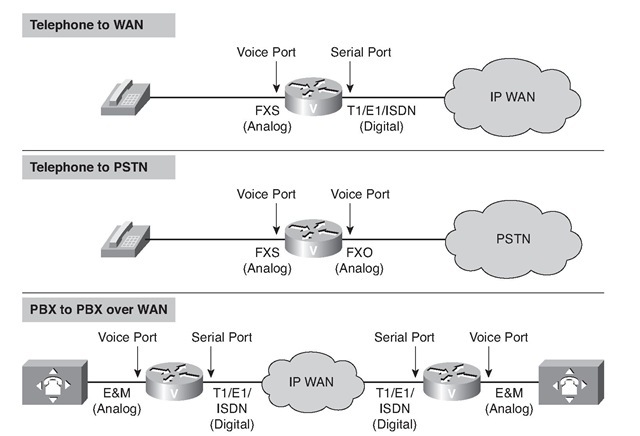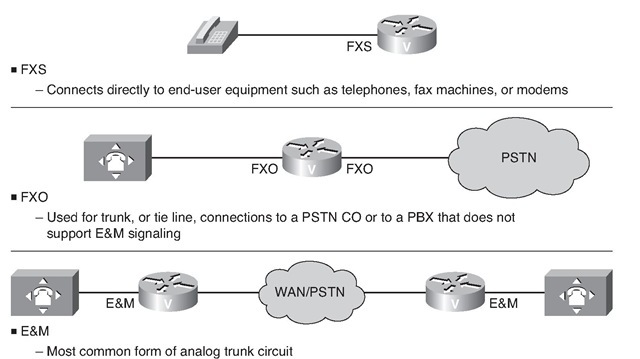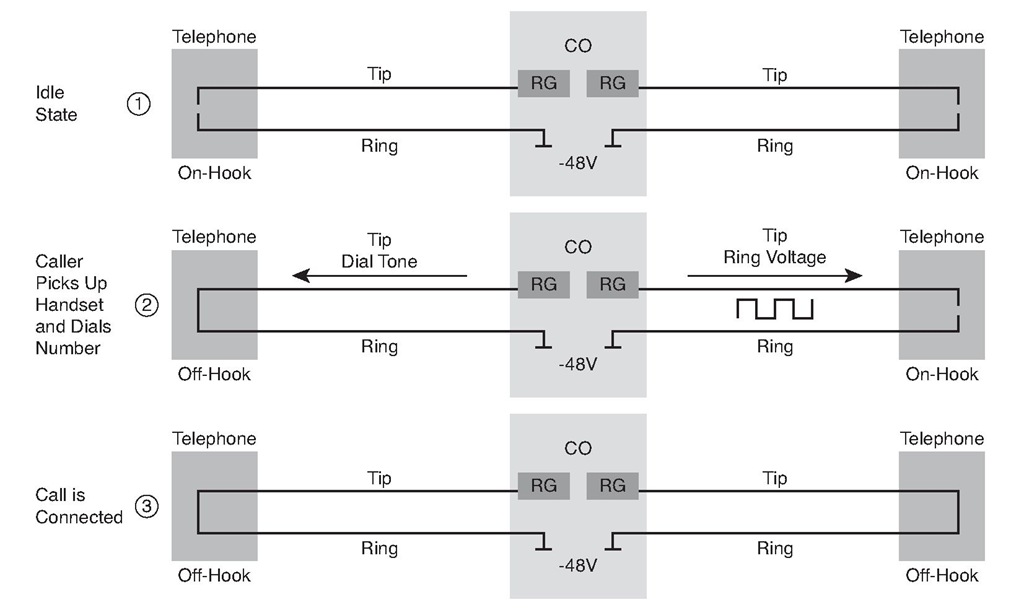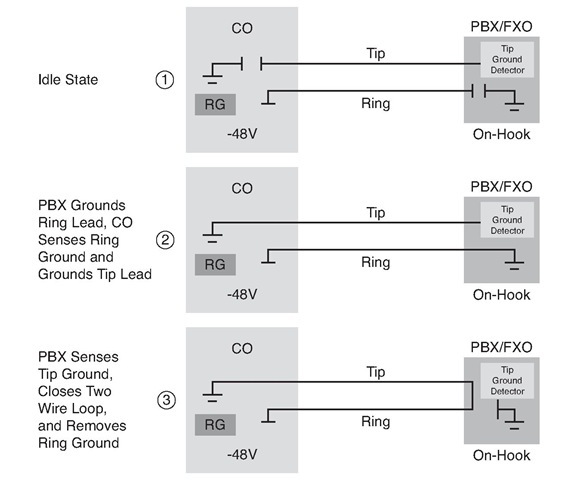Connecting voice devices to a network infrastructure requires an in-depth understanding of the signaling and electrical characteristics specific to each type of interface. Improperly matched electrical components can cause echo and create poor audio quality. Configuring devices for international implementation requires knowledge of country-specific settings. This section examines analog voice ports, analog signaling, and configuration parameters for analog voice ports.
Voice Ports
Voice ports on routers and access servers emulate physical telephony switch connections so that voice calls and their associated signaling can be transferred intact between a packet network and a circuit-switched network or device. For a voice call to occur, certain information must be passed between the telephony devices at either end of the call, such as the on-hook status of the devices, the availability of the line, and whether an incoming call is trying to reach a device. This information is referred to as signaling, and to process it properly, the devices at both ends of the call segment, which are directly connected to each other, must use the same type of signaling.
The devices in the packet network must be configured to convey signaling information in a way that a circuit-switched network can understand. They must also be able to understand signaling information that is received from the circuit-switched network. This is accomplished by installing appropriate voice hardware in a router or access server and by configuring the voice ports that connect to telephony devices or the circuit-switched network. Figure 3-8 shows typical examples of how voice ports are used.
Signaling Interfaces
Voice ports on routers and access servers physically connect the router, access server, or call control device to telephony devices such as telephones, fax machines, PBXs, and PSTN central office (CO) switches through signaling interfaces.
These signaling interfaces generate information about things such as
■ On-hook status
■ Ringing
■ Line seizure
The voice port hardware and software of the router need to be configured to transmit and receive the same type of signaling being used by the device they are interfacing with so calls can be exchanged smoothly between a packet network and a circuit-switched network.
Figure 3-8 Voice Ports
The signaling interfaces discussed in the next sections include FXO, FXS, and E&M, which are types of analog interfaces. Digital signaling interfaces include T1, E1, and ISDN. Some digital connections emulate FXO, FXS, and E&M interfaces. It is important to know which signaling method the telephony side of the connection is using and to match the router configuration and voice interface hardware to that signaling method.
Analog Voice Ports
Analog voice port interfaces connect routers in packet-based networks to analog two-wire or four-wire circuits in telephony networks. Two-wire circuits connect to analog telephone or fax devices, and four-wire circuits connect to PBXs. Connections to the PSTN CO are typically made with digital interfaces. Three types of analog voice interfaces are supported by Cisco gateways, as illustrated in Figure 3-9.
The following is a detailed explanation of each of the three types of analog voice interfaces:
■ FXS: An FXS interface connects the router or access server to end-user equipment such as telephones, fax machines, or modems. The FXS interface supplies ring, voltage, and dial tone to the station and includes an RJ-11 connector for basic telephone equipment, key sets, and PBXs.
Figure 3-9 Analog Voice Ports
■ FXO: An FXO interface is used for trunk, or tie-line, connections to a PSTN CO or to a PBX that does not support E&M signaling (when the local telecommunications authority permits). This interface is of value for off-premises station applications. A standard RJ-11 modular telephone cable connects the FXO voice interface card to the PSTN or PBX through a telephone wall outlet.
■ E&M: Trunk circuits connect telephone switches to one another. They do not connect end-user equipment to the network. The most common form of analog trunk circuit is the E&M interface, which uses special signaling paths that are separate from the trunk audio path to convey information about the calls. The signaling paths are known as the E-lead and the M-lead. E&M connections from routers to telephone switches or to PBXs are preferable to FXS and FXO connections because E&M provides better answer and disconnect supervision.
The name E&M is thought to derive from the phrase Ear and Mouth or rEceive and transMit, although it could also come from Earth and Magneto. The history of these names dates back to the early days of telephony, when the CO side had a key that grounded the E circuit, and the other side had a sounder with an electromagnet attached to a battery. Descriptions such as Ear and Mouth were adopted to help field personnel understanding and determine the direction of a signal in a wire.
Like a serial port, an E&M interface has a DTE/DCE type of reference. In the telecommunications world, the trunking side is similar to the DCE and is usually associated with CO functionality. The router acts as this side of the interface. The other side is referred to as the signaling side, like a DTE, and is usually a device such as a PBX.
Note Depending on how the router is connected to the PSTN, the voice gateway might provide clocking to an attached key system or PBX, because the PSTN has more accurate clocks, and the voice gateway can pass this capability to downstream devices.
Analog Signaling
The human voice generates sound waves, and the telephone converts the sound waves into electrical signals, analogous to sound. Analog signaling is not robust because of line noise. Analog transmissions are boosted by amplifiers because the signal diminishes the farther it travels from the CO. As the signal is boosted, the noise is also boosted, which often causes an unusable connection.
In digital networks, signals are transmitted over great distances and coded, regenerated, and decoded without degradation of quality. Repeaters amplify the signal and clean it to its original condition. Repeaters then determine the original sequence of the signal levels and send the clean signal to the next network destination.
Voice ports on routers and access servers physically connect the router or access server to telephony devices such as telephones, fax machines, PBXs, and PSTN CO switches. These devices might use any of several types of signaling interfaces to generate information about on-hook status, ringing, and line seizure.
Signaling techniques can be placed into one of three categories:
■ Supervisory: Involves the detection of changes to the status of a loop or trunk. When these changes are detected, the supervisory circuit generates a predetermined response. A circuit (loop) can close to connect a call, for example.
■ Addressing: Involves passing dialed digits (pulsed or tone) to a PBX or CO. These dialed digits provide the switch with a connection path to another phone or customer premises equipment (CPE).
■ Informational: Provides audible tones to the user, which indicates certain conditions such as an incoming call or a busy phone.
FXS and FXO Supervisory Signaling
FXS and FXO interfaces indicate on-hook or off-hook status and the seizure of telephone lines by one of two access signaling methods: loop-start or ground-start. The type of access signaling is determined by the type of service from the telephone company’s CO. Standard home telephone lines use loop-start, but business telephones can order ground-start lines instead.
Loop-Start
Loop-start, as shown in Figure 3-10, is the more common of the access signaling techniques. When a handset is picked up (the telephone goes off-hook), this action closes the 48 V circuit that draws current from the telephone company CO and indicates a change in status, which signals the CO to provide a dial tone. An incoming call is signaled from the CO to the called handset by sending a signal in a standard on/off pattern, which causes the telephone to ring. When the called subscriber answers the call, the 48V circuit is closed and the CO turns off the ring voltage. At this point, the two circuits are tied together at the CO.
Figure 3-10 Loop-Start Signaling
The loop-start signaling process is as follows:
Step 1. In the idle state, the telephone, PBX, or FXO module has an open two-wireloop (tip and ring lines open). It could be a telephone set with the handset on-hook or a PBX or FXO module that generates an open between the tip and ring lines. The CO or FXS waits for a closed loop that generates a current flow. The CO or FXS have a ring generator connected to the tip line and -48VDC on the ring line.
Step 2. A telephone set, PBX, or FXO module closes the loop between the tip and ring lines. The telephone takes its handset off-hook or the PBX or FXO module closes a circuit connection. The CO or FXS module detects current flow and then generates a dial tone, which is sent to the telephone set, PBX, or FXO module. This indicates that the customer can start to dial. At the same time, the CO or FXS module seizes the ring line of the telephone, PBX, or FXO module called by superimposing a 20 Hz, 90 VAC signal over the -48VDC ring line. This procedure rings the called party telephone set or signals the PBX or FXS module that there is an incoming call. The CO or FXS module removes this ring after the telephone set, PBX, or FXO module closes the circuit between the tip and ring lines.
Step 3. The telephone set closes the circuit when the called party picks up the handset. The PBX or FXS module closes the circuit when it has an available resource to connect to the called party.
Loop-start has two disadvantages:
■ There is no way to prevent the CO and the subscriber from seizing the same line at the same time, a condition known as glare. It takes about four seconds for the CO switch to cycle through all the lines it must ring. This delay in ringing a phone causes the glare problem because the CO switch and the telephone set seize a line simultaneously. When this happens, the person who initiated the call is connected to the called party almost instantaneously, with no ring-back tone.
Note The best way to prevent glare is to use ground-start signaling.
■ It does not provide switch-side disconnect supervision for FXO calls. The telephony switch is the connection in the PSTN, another PBX, or key system. This switch expects the FXO interface of the router, which looks like a telephone to the switch, to hang up the calls it receives through its FXO port. However, this function is not built in to the router for received calls. It operates only for calls originating from the FXO port.
These disadvantages are usually not a problem on residential telephones, but they become significant with the higher call volume experienced on business telephones.
Ground-Start
Ground-start signaling, as shown in Figure 3-11, is another supervisory signaling technique, like loop-start, that provides a way to indicate on-hook and off-hook conditions in a voice network. Ground-start signaling is used primarily in switch-to-switch connections. The main difference between ground-start and loop-start signaling is that ground-start requires ground detection to occur in both ends of a connection before the tip and ring loop can be closed.
Figure 3-11 Ground-Start Signaling
Ground-start signaling works by using ground and current detectors that allow the network to indicate off-hook or seizure of an incoming call independent of the ringing signal and allow for positive recognition of connects and disconnects. Because ground-start signaling uses a request and/or confirm switch at both ends of the interface, it is preferable over FXOs and other signaling methods on high-usage trunks. For this reason, ground-start signaling is typically used on trunk lines between PBXs and in businesses where call volume on loop-start lines can result in glare.
The ground-start signaling process is as follows:
Step 1. In the idle state, both the tip and ring lines are disconnected from ground.
The PBX and FXO constantly monitor the tip line for ground, and the CO and FXS constantly monitor the ring line for ground. Battery (-48 VDC) is still connected to the ring line just as in loop-start signaling.
Step 2. A PBX or FXO grounds the ring line to indicate to the CO or FXS that there is an incoming call. The CO or FXS senses the ring ground and then grounds the tip lead to let the PBX or FXO know that it is ready to receive the incoming call.
Step 3. The PBX or FXO senses the tip ground and closes the loop between the tip and ring lines in response. It also removes the ring ground.




